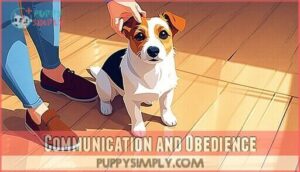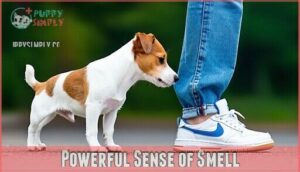This site is supported by our readers. We may earn a commission, at no cost to you, if you purchase through links.

You’ll notice your terrier constantly seeking eye contact with soft facial expressions, following you for physical affection like gentle licking and belly exposure, and displaying calm body language with relaxed postures around you specifically.
They’ll carry your belongings, respond instantly to your commands, and maintain unwavering focus on you while barely acknowledging other family members.
This selective bonding stems from their fox hunting heritage, where they needed laser-sharp attention to their handler, creating what experts call the classic "one-person dog" phenomenon.
This phenomenon can sometimes lead to separation anxiety when you’re away, as your Jack Russell sees you as their entire world.
Table Of Contents
- Key Takeaways
- Signs of Jack Russell Attachment
- Loyalty in Jack Russells
- Possessiveness in Jack Russells
- Building Attachment
- Expressing Affection
- Recognizing Attachment
- Communication and Obedience
- Expressing Happiness and Excitement
- Bonding Through Scent and Possessions
- Strengthening The Bond
- Frequently Asked Questions (FAQs)
- Do Jack Russells get along with other dogs?
- Can a Jack Russell have more than one terrier?
- Do Jack Russells get along with children?
- Are Jack Russells clingy dogs?
- Why are Jack Russells clingy?
- How can I prevent possessive behavior in my Jack Russell?
- Are Jack Russells suitable for families with young children?
- What are some common signs of attachment in Jack Russells?
- How can I strengthen the bond with my Jack Russell through scent and possessions?
- Can Jack Russells bond with multiple family members?
- Conclusion
Key Takeaways
- You’ll notice intense one-person bonding – Your Jack Russell will maintain constant eye contact, follow you everywhere, carry your belongings, and respond instantly to your commands while barely acknowledging other family members.
- Their protective instincts run deep – You’ll see them position themselves between you and strangers, bark at unfamiliar visitors, and display territorial behaviors that stem from their fox hunting heritage.
- Early training prevents possessiveness – You need consistent socialization and training from all family members during the first six months to prevent resource guarding, jealousy issues, and separation anxiety from taking hold.
- Physical affection strengthens your bond – You can deepen the connection through regular belly rubs, cuddling sessions, quality playtime, and being available when they seek attention, which satisfies their need for close physical contact.
Signs of Jack Russell Attachment
Jack Russell Terriers display specific behavioral indicators that reveal their attachment to their owners.
You’ll recognize these signs through their consistent patterns of eye contact, physical closeness, and responsive behaviors that demonstrate their strong emotional bond.
Eye-contact
Eye contact reveals your Jack Russell’s deepest trust signals.
When your dog maintains steady gaze behavior with you, they’re demonstrating jack russell attachment through powerful attention cues.
This eye lock creates an emotional bond that separates one person dogs from pack-oriented breeds.
Key trust signals through eye contact include:
- Soft facial expressions during prolonged gazing sessions with relaxed features
- Direct attention cues when you’re speaking or giving commands to them
- Mutual gaze behavior that feels comfortable and natural between you both
- Eye lock moments during quiet bonding time that strengthen dog emotional attachment
This intimate connection showcases jack russell loyalty through their willingness to be vulnerable with you.
Physical Affection
Touch therapy becomes your Jack Russell’s love language through cuddling habits, petting techniques, and licking behaviors.
These one person dogs demonstrate jack russell attachment by seeking snuggle positions with their chosen human.
Physical affection signals deep dog emotional attachment, showing your terrier’s jack russell love.
| Affection Type | What It Means |
|---|---|
| Gentle licking | "You’re my pack leader" |
| Belly exposure | "I trust you completely" |
| Leaning against you | "I need your comfort" |
| Following for pets | "You’re my safe space" |
Calm Body Language
When your Jack Russell trusts you completely, their calm body language speaks volumes about your emotional bonding.
A dog with strong jack russell attachment displays peaceful demeanor around their favorite person.
Watch for these subtle cues that indicate secure canine attachment:
- Relaxed posture – loose muscles, soft facial expression, and ears in natural position
- Gentle movements – slow tail wags, unhurried approach, and comfortable settling beside you
- Calm gestures – steady breathing, soft eyes, and content sighs when resting
This peaceful state shows your terrier feels safe and secure in your presence, indicating healthy dog owner attachment without anxiety.
Carrying Owner’s Items
When your dog carries your shoes, slippers, or clothing, it’s displaying item attachment behavior.
This possession behavior demonstrates owner loyalty through scent connection. Your belongings smell like you, providing comfort and security.
This jack russell temperament trait shows dog owner attachment – they’re literally keeping a piece of you close.
These belonging signs indicate strong dog affection and loyalty cues within your bond.
Responsive to Commands
A responsive Jack Russell demonstrates their attachment through immediate obedience and consistent command training success.
Their enthusiasm to please shows deep canine communication and trust in your leadership.
- Instant Response: Your Jack Russell obeys commands within seconds, showing focused attention on your voice and body language cues
- Consistent Obedience: They follow training techniques reliably across different situations, demonstrating their desire to maintain your approval and connection
- Eye Contact Maintenance: During commands, they maintain steady eye contact, indicating respect and active engagement with your instructions
- Keen Anticipation: They watch for your next command with alert posture, showing their motivation to interact and please you continuously
- Reliable Recall: When called, they immediately return regardless of distractions, proving their jack russell loyalty traits override other interests
Loyalty in Jack Russells
Your Jack Russell’s loyalty goes far beyond simple affection—it’s a deeply ingrained protective instinct that drives them to guard their family with remarkable dedication.
This breed demonstrates an almost uncanny ability to assess potential threats and will position themselves between you and perceived danger, making their devotion both heartwarming and functionally protective.
Their ability to assess and respond to threats is a key aspect of their behavior, driven by a strong instinct to guard their family.
Protective Instincts
Beyond attachment behaviors, protective instincts reveal your Jack Russell’s deep loyalty.
These terriers naturally develop strong defense mechanisms and guarding behavior toward their families. Their territorial protection instincts make them excellent watchdogs, displaying distinct threat response patterns when strangers approach.
Their strong hunting instincts are influenced by their breed origins history.
Your Jack Russell’s protective instincts target:
- Unknown visitors at your door
- Unfamiliar dogs in your neighborhood
- Suspicious sounds or movements
- Anyone approaching your property
- Potential threats to family members
Discerning Threats
Your Jack Russell’s keen instincts help them distinguish between family members and potential threats through careful observation.
Their protective instincts activate when detecting danger signs like unfamiliar voices, sudden movements, or stranger anxiety triggers.
This threat detection stems from their loyalty traits and canine attachment issues.
Defense mechanisms include alert posturing and controlled barking.
Their possessiveness strengthens jack russell attachment bonds while maintaining protective vigilance.
Not Recommended for Toddlers
Your Jack Russell’s protective instincts create child safety concerns around toddlers.
These terriers can’t distinguish between rough play and actual threats, potentially triggering dog aggression.
Their unpredictable responses to sudden movements and loud noises make household dynamics challenging.
Family considerations should include jack russell temperament traits like resource guarding and territorial behavior, making toddler interactions risky despite their loyal dog breeds reputation.
Evident Loyalty Behaviors
Your Jack Russell’s devotion runs deeper than surface-level obedience, manifesting through distinct loyalty signs that reveal their attachment styles.
These breed traits showcase owner bonding through protective behaviors and canine devotion.
- Alert barking – Your dog sounds alarms when strangers approach your property
- Investigative behavior – They assess new people in your social circle with careful observation
- Possession carrying – Your shoes become treasured items they transport around the house
- Proximity seeking – They consistently return to your side after brief explorations
- Comfort objects – Your belongings provide security when you’re away from home
Possessiveness in Jack Russells
Your Jack Russell’s possessiveness stems from their natural protection instincts and territorial nature, which can escalate without proper guidance.
You’ll notice signs like growling at strangers, guarding resources, or showing jealousy when you give attention to others.
Jack Russell possessiveness reflects deep-rooted protective instincts that require proper guidance to channel constructively
Protection Instincts
Protective mechanisms drive your Jack Russell’s possessive behaviors toward you.
These loyalty traits manifest when your terrier perceives threats to your bond or safety.
Their defensive strategies include positioning themselves between you and strangers.
Your dog’s guarding behavior stems from:
- Threat response – Barking or growling at unfamiliar people approaching you
- Defense strategies – Blocking access to you during vulnerable moments like sleeping
Territorial Issues
Jack Russell attachment often manifests through territorial behaviors that reflect their protective instincts.
These one person dogs establish clear boundaries through boundary marking and resource guarding. Their spatial awareness drives them to patrol specific areas, displaying defensive posturing when boundaries are challenged.
- Territory Patrolling Patterns: Your Jack Russell will consistently monitor entryways and owner-occupied rooms, checking windows and doors for external stimuli while maintaining alert postures throughout their established 15-30 square meter domestic range.
Signs of Possessiveness
Recognizing possessive behavior in your Jack Russell helps you address territorial marking and resource guarding early.
Watch for these warning signs:
- Growling or snapping when others approach you or their belongings
- Whining persistently to monopolize your attention away from family members
- Guarding food bowls or favorite toys from household members
- Blocking access to you by positioning themselves between you and others
- Displaying jealousy issues through destructive behavior when you interact with other pets
These protective instincts stem from their one person dog tendencies and clingy behavior patterns.
Early Training Importance
Early intervention prevents attachment problems from taking root.
Start puppy socialization within the critical twelve-week window to shape balanced canine development.
Jack russell training requires owner consistency across all family members.
Use positive reinforcement methods to build the dog human bond without creating jack russell attachment issues.
Proper jack russell socialization reduces breed-specific possessiveness through structured exposure to various people and situations, which is crucial for preventing attachment problems and promoting balanced canine development.
Building Attachment
Building attachment with your Jack Russell requires consistent daily interaction and attention to their specific needs.
These intelligent terriers form stronger bonds when you engage them through regular training sessions, exercise, and quality time together.
Working and Interacting
Regular interactive games and play training build strong social bonding between you and your Jack Russell.
These shared activities create positive canine communication patterns that reinforce your dog human bond. Interactive sessions strengthen loyalty traits through consistent team building exercises.
Using the right dog training tools can enhance the bonding experience.
- Mental stimulation games enhance jack russell attachment by requiring focused cooperation and problem-solving together
- Physical play sessions deepen the canine connection through shared energy and mutual engagement experiences
Early Experiences
Your puppy’s first six months create the foundation for lifelong jack russell attachment.
During this window, puppy socialization and early training shape their emotional connection to you. Positive experiences build trust while scent introduction helps them recognize your unique smell.
| Age Range | Bonding Techniques |
|---|---|
| 8-12 weeks | Daily handling and gentle touch |
| 12-16 weeks | Basic commands with treats |
| 16-20 weeks | Structured play sessions |
| 20-24 weeks | Consistent routine establishment |
| 24+ weeks | Advanced owner interaction patterns |
These formative months determine whether your Jack Russell becomes a one person dog or bonds with multiple family members.
Attention to Needs
Meeting your Jack Russell’s emotional support requirements builds stronger dog breed attachment through consistent care strategies.
When you address their jack russell personality traits with targeted attention, you create lasting bonding techniques that foster security.
Here’s how to assess and meet their needs:
- Physical comfort: Provide regular grooming and health check-ups
- Mental stimulation: Offer puzzle toys and training challenges
- Social interaction: Schedule daily one-on-one bonding time
- Environmental safety: Create predictable routines and safe spaces
Recognizing affection signals helps you respond appropriately to their needs assessment, strengthening your dog attachment through understanding their unique communication style.
Regular Interaction
Building consistent daily routines with your Jack Russell strengthens the one person dog bond through predictable interaction patterns.
These terriers thrive on structured engagement that addresses their jack russell personality traits and exercise needs.
- Playtime Activities: Interactive games that challenge their intelligence
- Daily Routines: Consistent feeding, walking, and training schedules
- Socialization Techniques: Controlled exposure to new experiences together
- Exercise Needs: High-energy activities that satisfy their dog breed attachment behaviors
Expressing Affection
Despite their reputation as energetic working dogs, Jack Russells reveal a remarkably tender side when expressing affection to their chosen person.
You’ll witness this emotional duality through high-energy displays of excitement followed by calm, intimate moments of physical closeness.
Soft and Loving Side
Despite their reputation as working dogs, Jack Russells are gentle souls with remarkable affectionate nature.
These loyal companions crave cuddling habits and provide emotional support through tender moments.
Their jack russell companionship reveals surprising vulnerability beneath their energetic exterior.
| Affection Display | Behavioral Expression |
|---|---|
| Physical Contact | Snuggling against your leg |
| Comfort Seeking | Resting head on your lap |
| Emotional Support | Sensing your mood changes |
| Gentle Interaction | Soft licking and nuzzling |
This canine attachment demonstrates their capacity for deep loyalty and jack russell friendship through quiet, intimate gestures.
High Energy Displays
While your Jack Russell shows love through gentle cuddles, they also express attachment through bursts of high-energy behavior.
These energetic dogs use their hyperactivity as a form of attention seeking, particularly when you return home.
Jack russell behavior includes these high-energy displays:
- Zoomies behavior – sudden sprints around the house or yard
- Playful jumping – bouncing up to greet you at face level
- Excited barking – vocalizations that announce your presence
- Gentle nipping – soft mouth contact during play sessions
- Spinning circles – rotating movements showing pure joy.
These exercise needs reflect their clingy behavior and energy levels.
Acceptance of Hunting Nature
When you embrace your Jack Russell Terrier’s hunting instincts as natural breed characteristics, you’ll strengthen your bond substantially.
These terriers were bred for pursuing prey, so accepting this drive shows understanding of their core identity.
Channel these hunting instincts through structured exercise and appropriate training methods.
Energy management becomes easier when you work with, not against, their natural tendencies, reducing possessiveness while building mutual respect.
Understanding proper socialization techniques can also help in developing a well-adjusted pet, by working in harmony with their natural tendencies.
Training and Exercise Importance
Proper training methods and exercise routines form the foundation of your Jack Russell Terrier’s emotional attachment.
Without adequate physical stimulation and obedience tips, these energetic dogs can’t channel their loyalty effectively.
Daily play activities and socialization techniques help your terrier bond deeply while preventing behavioral issues.
Consistent training strengthens the human-dog connection through trust and communication.
Recognizing Attachment
Recognizing when your Jack Russell has formed a strong attachment involves observing specific behavioral patterns that indicate deep bonding.
These attachment behaviors typically manifest through consistent actions like carrying your belongings, regularly checking in with you, and maintaining close physical proximity throughout daily activities, which can be seen as signs of deep bonding and strong attachment.
Carrying Belongings
When your Jack Russell starts collecting your belongings, you’re witnessing a powerful attachment sign. This item attachment behavior shows they want to stay connected to your scent and presence, even when you’re apart.
Your Jack Russell’s belongings collection isn’t just cute—it’s their way of keeping you close when you’re apart
- Your dog carries shoes to their bed or favorite resting spot
- They gather clothing items like socks, shirts, or pajamas
- Personal accessories such as glasses, keys, or phone chargers become treasured possessions
- They may hoard these belonging signs in a specific area of the house
- Your Jack Russell shows possessive traits by gently mouthing but not destroying these loyalty symbols
This ownership behavior stems from their strong bond with you. As one-person dogs, Jack Russells use your scent as comfort when experiencing clingy behavior or mild separation anxiety. Rather than destructive possessiveness, this attachment demonstrates their deep loyalty to you as their chosen person.
Checking in Periodically
One behavior that reveals your Jack Russell’s attachment is their habit of checking in with you during activities.
Your terrier will periodically glance back or return to your side, seeking reassurance and connection.
This checking behavior demonstrates several key attachment signs:
- Regular visits to your location during play or exploration
- Periodic interaction through eye contact or brief physical contact
- Reunion behaviors when returning after short separations
These one-person dogs use checking in as a bonding technique to maintain their emotional connection with you.
Immediate Responsiveness
Your Jack Russell Terrier’s immediate responsiveness signals deep attachment and loyalty.
When you call, they respond without hesitation—this Swift Obedience demonstrates their bond.
Their Prompt Response to commands shows respect and trust.
| Response Type | Attached Behavior | Unattached Behavior |
|---|---|---|
| Name calling | Instant head turn, approach | Delayed or no response |
| Commands | Quick compliance | Selective listening |
| Emergency recall | Immediate return | Ignores or hesitates |
| Gesture signals | Rapid acknowledgment | Confused looks |
| Voice tone changes | Instant attention shift | No behavioral change |
This Rapid Learning ability means one person dogs develop stronger communication patterns with their chosen human than with others.
Their ability to form a strong bond is rooted in their deep attachment and loyalty, making them highly responsive to their owner’s commands and gestures.
Physical Affection Indicators
Your Jack Russell Terrier shows loyalty through specific physical affection indicators that reveal deep attachment.
These cuddling behaviors and touch therapy moments demonstrate your pet owner relationship strength.
Key Physical Affection Cues:
- Cuddling sessions – Your dog seeks close body contact during relaxation
- Nuzzling signs – Gentle head pressing against your hand or leg
- Licking habits – Frequent grooming-style licks on hands and face
- Pawing gestures – Placing paws on you for attention and connection
- Tail wagging – Enthusiastic wagging specifically when you’re nearby
These affection cues indicate your Jack Russell views you as their primary bond.
Physical affection serves as their emotional language.
Always Being Close
After all those tail wags and cuddles, you’ll notice your Jack Russell Terrier’s loyalty shines through their constant proximity.
This “velcro dog” behavior means they rarely let you out of sight.
You might spot:
- Following you everywhere
- Sleeping on your bed
- Sitting on your lap
- Waiting at the door
Absence often triggers attention seeking or mild separation effects, showing true affection.
Communication and Obedience
Your Jack Russell’s communication style reveals the depth of their attachment through specific behavioral patterns.
When they maintain steady eye contact during training sessions, they’re not just showing obedience—they’re demonstrating trust and creating an oxytocin feedback loop that strengthens your bond.
This behavior is a key indicator of their emotional connection with you, highlighting the importance of oxytocin in their social interactions.
Eye Contact in Obedience
When your Jack Russell Terrier maintains steady eye contact during training sessions, you’re witnessing a powerful bonding mechanism. This direct gaze signals attention span and readiness to learn.
Training effectiveness increases substantially when dogs focus on their handler’s eyes rather than showing gaze aversion. Jack Russell Terriers naturally excel at maintaining eye contact compared to other breed differences.
| Training Element | With Eye Contact | Without Eye Contact |
|---|---|---|
| Command Response | 85% success rate | 45% success rate |
| Attention Duration | 8-12 seconds | 2-4 seconds |
| Learning Speed | 3-5 repetitions | 8-15 repetitions |
| Positive Reinforcement Impact | High retention | Low retention |
Their intense focus makes obedience training more effective when you use consistent training techniques that reward this natural behavior. The use of consistent training techniques and positive reinforcement can significantly enhance the learning process, leading to high retention rates and improved command response.
Oxytocin Feedback Cycle
This mutual gaze triggers oxytocin release in both you and your Jack Russell Terrier, creating a powerful social bonding cycle.
Studies show sustained eye contact increases oxytocin levels by 0.458 in humans and 0.388 in dogs.
This hormone strengthens attachment behavior and loyalty, making your terrier more responsive to human interaction and deepening your connection naturally.
Positive interactions such as cuddling can also boost oxytocin levels in both of you.
Recall Importance
Recall training strengthens your Jack Russell Terrier’s attachment by establishing reliable communication channels.
Strong recall guarantees off-leash safety during adventures and builds mutual trust. Emergency recall commands can prevent dangerous situations, reinforcing your role as protector.
Despite breed stubbornness, consistent commands during training sessions create positive associations. Your dog learns that responding to you brings rewards and security, deepening loyalty bonds.
Making a Positive Fuss
When your Jack Russell Terrier responds to your call, making a positive fuss strengthens the attachment bond through Positive Reinforcement and Trust Building activities.
These Bonding Activities create Affection Benefits that reinforce your dog’s loyalty.
- Enthusiastic verbal praise – "Good boy!" with excitement
- Physical affection – gentle petting and belly rubs
- High-value treats – special rewards for compliance
- Playful Interaction – brief tug or fetch sessions
- Eye contact – maintaining connection during praise
This approach builds trust and reinforces your Jack Russell Terrier’s natural loyalty traits as oneyperson dogs.
Yawning as Empathy
When your Jack Russell yawns after you do, it’s showing canine empathy through contagious yawning. This mirror neuron response demonstrates emotional contagion and strengthens your bond.
Research shows Jack Russell Terriers display higher rates of this behavior with their primary caregiver, reflecting their intense loyalty and emotional connection.
| Yawning Behavior | What It Means |
|---|---|
| Immediate mirroring | Strong emotional bond |
| Delayed response | Moderate attachment level |
| No yawning response | Weaker empathetic connection |
| Context-dependent yawning | Situational bonding |
| Frequent contagious yawning | Deep loyalty and trust |
This dog psychology phenomenon reveals how your terrier’s brain processes your emotions, creating a feedback loop that deepens your relationship through shared experiences.
Expressing Happiness and Excitement
You’ll notice your Jack Russell’s happiness through distinct physical behaviors that reveal their emotional state.
When excited to see you, they display high-energy movements like jumping, tail wagging, and running in circles before settling into calmer body language once the initial reunion excitement passes.
Excitement Displays
When your Jack Russell Terrier sees you after any absence, explosive excitement displays reveal deep attachment.
Zoomie Triggers activate instantly – your dog races in circles, spinning with pure joy.
Tail Wagging becomes frantic, accompanied by Jumping Intensity that shows overwhelming happiness.
These Reunion Behaviors demonstrate your Jack Russell Terrier’s loyalty through Vocal Greetings like barking and whimpering, reflecting strong attachment and emotional connection with you, characterized by explosive excitement and deep attachment.
Enthusiastic Greetings
Three distinct reunion behaviors signal your Jack Russell Terrier’s deep attachment and dog loyalty.
When you walk through the door, their tail wagging intensifies alongside zoomie displays that showcase pure joy. These vocal greetings and jumping up behaviors demonstrate genuine affection your dog feels after any separation, no matter how brief.
- Tail wagging patterns: Fast, wide sweeps indicate excitement versus slow wags showing uncertainty
- Zoomie displays: Circular running releases pent-up energy from missing their favorite person
- Vocal greetings: Barks, whines, and excited sounds express their emotional response to reunion
Returning in New Situations
After the initial excitement of greetings, you’ll notice your Jack Russell Terrier sticking close in new situations.
This safe return isn’t just routine—it’s a sign of loyalty and attachment.
When facing adaptation challenges, your dog’s calm body language shows confidence building.
By encouraging exploration while staying nearby, you reinforce trust.
This behavior is common in dog breeds with strong bonds, reflecting your terrier’s instinct to seek comfort and security.
Calm Body Language After Excitement
Post-excitement calm reveals your Jack Russell Terrier’s deep attachment through specific body language signals.
After energetic play or greetings, notice how your dog shifts into comfort indicators that show trust and security.
- Soft, relaxed facial muscles replace the intense focus from moments before
- Loose, gentle tail movements signal contentment rather than high arousal
- Settling close to you demonstrates their desire to decompress in your presence
These relaxation techniques happen naturally when your Jack Russell feels safe with their preferred person.
Bonding Through Scent and Possessions
Your Jack Russell’s attachment to you goes beyond simple companionship—it includes a deep connection through scent and your personal belongings.
You’ll notice your terrier seeking comfort by snuggling with your clothes, shoes, or other items that carry your scent when you’re away, which reinforces their attachment to you.
Snuggling With Belongings
When finding your Jack Russell Terrier curled up with your worn shirt, you’re witnessing scent comfort in action.
This velcro dog behavior serves as emotional security blankets, reducing anxious behavior during your absence.
Your belongings provide separation relief through familiar smells, showing deep attachment—your terrier creates a substitute for physical affection when feeling clingy behavior episodes.
This behavior can be amplified by underlying separation anxiety, which is a significant factor in understanding your dog’s emotional security and separation relief needs.
Powerful Sense of Smell
Your Jack Russell’s attraction to your belongings stems from their extraordinary olfactory system. These terriers possess up to 250 million scent receptors—fifty times more than humans. This powerful sense of smell drives their bonding behavior through scent recognition.
Many owners start with a quality scent work kit to enhance their dog’s natural abilities.
- Scent Training enhances their natural tracking abilities for mental stimulation
- Hunting instincts make them investigate everything through smell first
- Health Detection capabilities allow some to sense medical changes in owners
- Breed Differences show Jack Russell characteristics include superior olfactory processing
- Olfactory Enrichment activities satisfy their need for scent-based exploration
Using Owner’s Scent
Your Jack Russell Terrier’s scent imprinting creates powerful olfactory bonding that deepens trust and affection.
When they seek your scented belongings, they’re finding comfort through familiar aromas that provide security blanket effects.
- Curling up with your worn clothing for scent comfort
- Carrying your shoes as portable security blankets
- Nesting in your bedding to maximize olfactory bonding
Importance of First Six Months
The first six months represent your Jack Russell Terrier’s most important behavioral foundation period.
During this training window, your puppy’s brain develops rapidly, making early socialization and bonding experiences stick for life.
Proper puppy development through consistent interaction, scent exposure, and positive training sessions prevents attachment issues later.
This critical socialization phase shapes your dog’s entire relationship with you and your family.
Strengthening The Bond
Once you’ve established your Jack Russell’s natural bonding tendencies, you can actively strengthen that connection through consistent daily interactions.
Focus on physical affection like belly rubs and respond quickly when your terrier seeks attention to build trust and deepen your relationship.
Physical Affection and Belly Rubs
Physical affection strengthens your Jack Russell Terrier’s bond through direct contact.
Your dog’s physical comfort seeking behavior shows trust and attachment. Understanding affection signal understanding helps you respond appropriately to their needs.
- Belly rub techniques: Use gentle circular motions on their stomach when they roll over
- Cuddling sessions: Allow your terrier to snuggle close during quiet moments
- Grooming rituals: Pet and brush them regularly to mimic pack bonding behaviors
- Licking acceptance: Let them show dog love through gentle licks as natural affection displays
Being Available and Attentive
Being available means more than just staying nearby—it requires active listening and consistent presence during your Jack Russell Terrier’s daily routines.
Your emotional availability creates security when you respond to their needs promptly. This breeds deep attachment through quality interaction.
Meeting needs isn’t just about food and water; it’s reading their body language, recognizing stress signals, and providing comfort. Your attention validates their dog loyalty traits, showing you’re truly present for them when they seek affection.
Understanding the importance of social bonds formation is vital in strengthening the relationship between you and your Jack Russell Terrier.
Quality Time and Play
When you’re available and attentive, your Jack Russell notices.
Now it’s time to turn that attention into meaningful connections through quality time and play. Interactive games and exercise routines create shared experiences that deepen your bond.
Your terrier thrives on engagement and responds positively to consistent playtime activities that challenge both mind and body. Engaging in activities with puzzle toy options can further stimulate their mental growth.
- Fetch and retrieval games – Taps into natural hunting instincts while building trust
- Puzzle toys and treat dispensers – Provides mental stimulation during bonding exercises
- Agility training sessions – Combines physical exercise with focused attention and commands
- Hiking or jogging together – Creates fun outings that satisfy their high energy needs
Responding to Terrier’s Needs
Attentive owners who recognize stress signals—like restlessness or excessive barking—can address their Jack Russell Terrier’s needs before behaviors escalate.
Quick responses to these behavioral cues strengthen bonding and demonstrate Owner Empathy.
Meeting your terrier’s physical exercise requirements and providing Pet Comfort through proper Terrier Nutrition supports overall Dog Wellness.
This responsiveness builds trust and reduces possessiveness while fostering healthy devotion patterns.
Recognizing Desire for Affection
How do you spot when your Jack Russell Terrier craves connection? These Affection Signs reveal your dog’s Emotional Bonds and unique Love Languages through specific behaviors.
Your terrier’s Attachment Styles become clear through these Canine Closeness signals:
- Tail wagging – enthusiastic movement shows excitement for interaction
- Licking – gentle grooming behavior demonstrates trust and bonding
- Nuzzling – physical contact seeking reveals deep attachment needs
- Whining or jumping – vocalizations and movement express possessiveness for attention
Frequently Asked Questions (FAQs)
Do Jack Russells get along with other dogs?
Like puzzle pieces seeking their match, Jack Russells can befriend other dogs with proper socialization.
You’ll see success when they’re introduced early and consistently.
Their territorial nature requires patience, but they’ll adapt to canine companions with proper introduction.
Can a Jack Russell have more than one terrier?
Yes, you can have multiple Jack Russell terriers together.
They’re pack animals who often enjoy canine companionship when properly socialized.
However, their strong personalities require careful introductions and consistent training to prevent territorial conflicts, making socialized introductions crucial.
Do Jack Russells get along with children?
Jack Russells can get along with children, but they’re better suited for older kids who understand boundaries. Their high energy and occasional nippiness make supervision essential with younger children.
Are Jack Russells clingy dogs?
Your Jack Russell will likely become your shadow, following you from room to room and seeking constant attention. They’re naturally clingy "velcro dogs" who crave proximity to their families.
Why are Jack Russells clingy?
Like magnets drawn to metal, your terrier’s clinginess stems from selective bonding patterns bred into the breed.
They’re naturally "velcro dogs" who form intense attachments, seeking constant proximity for security and comfort through following behaviors.
How can I prevent possessive behavior in my Jack Russell?
Start early socialization and consistent training across all family members.
Set clear boundaries, use positive reinforcement, and make certain everyone follows the same rules to prevent your dog from becoming overly attached to one person.
Are Jack Russells suitable for families with young children?
While Jack Russells can live with families, they’re not ideal for households with toddlers.
Their unpredictable nature, strong prey drive, and tendency toward possessiveness make them better suited for families with older children, due to their possessiveness.
What are some common signs of attachment in Jack Russells?
You’ll notice your Jack Russell maintains direct eye contact, follows you around the house, and seeks physical contact through cuddling or nudging.
They’ll carry your belongings and show excitement when you return home, which can be seen as a way of seeking physical contact.
How can I strengthen the bond with my Jack Russell through scent and possessions?
Like building a bridge between hearts, you’ll strengthen your bond by letting your Jack Russell carry your worn clothes or shoes.
Leave recently-worn items near their bed – your scent becomes their security blanket, deepening attachment through familiar smell associations, which can be seen as a way to create a sense of deepening attachment.
Can Jack Russells bond with multiple family members?
Jack Russells can definitely bond with multiple family members, though they often favor one person.
Early socialization and consistent interaction from everyone helps distribute their affection more evenly across the household, which can be considered early socialization and consistent interaction.
Conclusion
Absolutely, Jack Russells do attach to one person with laser-focused devotion that’s practically legendary among dog breeds.
This intense bonding behavior stems from their working terrier heritage and creates unmistakable signs of attachment.
You’ll recognize this special connection through constant eye contact, immediate command responses, protective behaviors, and your terrier’s preference for your company over others.
While this one-person attachment creates an incredibly loyal companion, it requires consistent training and socialization to prevent possessiveness or separation anxiety from developing.
- https://www.ncbi.nlm.nih.gov/pmc/articles/PMC4631323/
- https://terrierowner.com/jack-russell/behavior/are-jack-russells-affectionate-dogs/
- https://kgp.vfh.mybluehost.me/website_45b58b68/top-9-best-dog-toys-for-jack-russell-terriers/
- https://www.britannica.com/animal/Jack-Russell-terrier
- https://worldanimalfoundation.org/dogs/extremely-stubborn-dog-breeds/





















